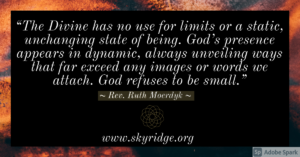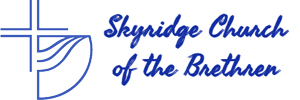 One of the books floating around the house when I was a teenager was entitled “Your God Is Too Small”, by the British minister and biblical scholar J.B. Phillips. This book was first published in 1953, but I remember reading an edition printed in the ’70s. Chances are I didn’t understand much of what I read at the time, and I don’t remember any of it now. One current description says “Many people are living without faith mainly because they have never found a God big enough” to encompass the realities of modern life. Phillips, it says, “explores several concepts of God which are narrow and inadequate” and explores further possibilities (books.google.com). 1953. A well-established British churchman sought to expand peoples’ notions and images of God. In 1953.
One of the books floating around the house when I was a teenager was entitled “Your God Is Too Small”, by the British minister and biblical scholar J.B. Phillips. This book was first published in 1953, but I remember reading an edition printed in the ’70s. Chances are I didn’t understand much of what I read at the time, and I don’t remember any of it now. One current description says “Many people are living without faith mainly because they have never found a God big enough” to encompass the realities of modern life. Phillips, it says, “explores several concepts of God which are narrow and inadequate” and explores further possibilities (books.google.com). 1953. A well-established British churchman sought to expand peoples’ notions and images of God. In 1953.
Wrestling with language and images about the Divine has always existed in the Christian church. Too often, church institutions and participants have grabbed on to a metaphor and turned it into an idol, an unchangeable article of faith supposedly immune to changes in cultural and scientific understandings.
For example, the Bible describes an instance where the warrior Joshua stopped the sun in the sky in order to extend daylight long enough to win a battle. This story was part of the “biblical” argument against scientific proof that the earth rotates around the sun because…well…in order to stop it the sun must rotate around the earth.
And, of course, God’s representatives on earth had anointed the ancient kings of Israel. So it only stood to reason that God’s plan for the world included the notion that kings were the anointed ones of God, and must not be opposed or overthrown.
Over and over again church institutions and their followers have taken a metaphor, an image, a scripture and used it to buttress scientifically indefensible and socially destructive positions. Worst of all is when we make idols of our images and metaphors, and wreak havoc because of it. If God is Christian, for example, members of other religions do not reflect the image of God, and so are lesser people than us.
We forget that any image of God is just a glimpse. It would be pretty easy to assert that we are destroying each other and the earth all because our God is too small.
One—only one—realm of understanding where we make God too small is in our understandings of gender. As a culture we are stuck in the notion of clearly distinct binaries of male and female, masculine and feminine. Genesis, though, indicates that the Creator is non-binary, beyond and between the distinctions of gender we agonize over as a culture. God created humanity in their own image, “our image,” says the text. Male and female. And, one supposes, an infinite God holds infinite possibilities generated by the interplay of what we call male and female. God, it turns out, has a remarkably fluid and flexible sense of gender in this scripture. Many aspects of creation reflect that. The most common example is probably seahorses: male seahorses are those who give birth. The image of God, the imago dei, in which we are made encompasses the nonbinary, a fluid and flexible sense of gender.
This is more than an utterly oversimplified summary of a lot of biblical scholarship. This is more than the beginning of an explanation for using the pronoun “they” to refer to God. Actual lives are at stake in this conversation. Real people…trans people…queer people…nonbinary people commit suicide every day. Experience depression and homelessness and hate and discrimination every day. Get murdered every day. Partly because Christian institutions and individuals have made an idol out of the metaphorical description of God as male. God as part of a binary. Making God too small creates suffering and dying.
God resists and stymies human categories throughout scripture. Moses asked the holy Presence in a burning bush what to say when people asked who sent him to free the Israelites from slavery in Egypt. “Tell them I AM sent you.” says God. Most translations then have God say “I AM WHAT I AM.” More accurate translations have God say “I will be what I will be.”
In other words, the Divine has no use for limits or a static, unchanging state of being. God’s presence appears in dynamic, always unveiling ways that far exceed any images or words we attach. God refuses to be small.
We’re human, though. And we’re humans who yearn for relationship with the Divine. We mainly depend upon images and metaphor to articulate that relationship. That Presence within and among us. The Bible offers images for the Holy One such as shepherd, rock, shield, comforter, spouse, woman in labor, bread of life, mother. Our own lives of prayer and reflection can generate others: river of life, listening one, friend, gardener, maker of music, gentle light, lover…
Every time a new image of God enters our prayer life and sets roots in our hearts, our understanding of the Holy grows. The breadth and depth of our connectedness strengthens. We limit our images and language for God far too much; in the process we limit our experience of the Divine. And willfully limiting our sense of the Divine helps engrain habits of thought and belief that get in the way of loving others, embracing the full range of humanity. Expansive language for God is a matter of enriching and growing in our spiritual lives. A matter of loving God and neighbor more fully. A matter of resisting the temptation to make God too small.
One of the metaphors for God I have been reflecting on lately totally challenges and stretches my imagination. It doesn’t make any logical sense at all…and it’s not clear who originated it. It’s a saying that seems to have been around since the 12th century or so. “God is a circle whose center is everywhere and whose circumference is nowhere.” Another way of getting at the same idea might be to say that God is small enough to be within each of us and large enough to be in everything. It’s a puzzle. It’s a paradox.
Try to imagine it: God is a circle whose center is everywhere and whose circumference is nowhere. Everything falls within God’s care, from this itty-bitty planet to the edges of the expanding cosmos. From the drop of water feeding your houseplant to the very different waters at the bottom of the Marianas Trench. From the war refugees of Syria to those who made the weapons that destroyed the nation’s cities. Everything is within God’s circles…no exceptions.
Expanding our images, our language, our metaphors for the Divine expands our relationship, our spiritual life. Expanding our images, our language, our metaphors for the Divine also deeply affects our actions in the world individually and collectively. When our God is small, our hearts stay small. May we have the faithful boldness to expand our metaphors for God’s circle of Presence, love, forgiveness, grace, and joy.
-Rev. Ruth Moerdyk
Scriptures: Genesis 1:26-27 and Exodus 3:10-15
